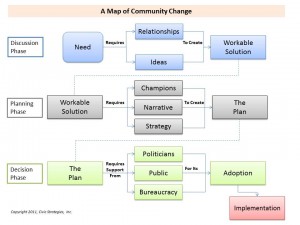In a series of postings, we’re exploring how conscious change happens in communities. If you haven’t read the first posting in this series, please take a moment to do so.
At the end of the discussion phase, the guiding coalition settles on a workable solution. But what makes solution workable? And how will you know when the group finds one?
Actually, these are good questions for the guiding coalition. Ask members as they begin their work to say how they want to judge the solutions they’re about to consider. Write down the criteria they suggest, combine them into a small set of standards and hand them back to the group at your next meeting.
This may seem a little touchy-feely but it’s actually strategic. If you can get the group to set criteria early on, you’ll be able to steer it away from inadequate solutions (because they don’t meet the criteria) and free it from dead-end discussions (by reminding members of what they’re looking for). It will also help convince members when it comes time to dig deeper. If none of the alternatives they’re considering meets the criteria they’ve set, it’s time to expand the search for answers.
So, in every way, it’s better if the coalition sets its own standards. Still, you may want to think beforehand about what makes a solution . . . well, workable. Here are some starter ideas.
- A workable solution answers the need. It’s surprising how often groups that are deep into the details forget why they started. As a leader, you can contribute to the coalition’s work simply by asking, “Does this really solve the problem?”
- A workable solution can win the support of decision makers and the citizens—with hard work. Your “market test” discussions along the way will gauge this, but in the end it’s a judgment call: Do the members think they can gain enough support to win approval?
- A workable solution is practical and sustainable. There are a number of tests here: Is the solution financially feasible? Will it attract the human resources (volunteers, staff, etc.) it will need? Can it maintain its political and popular support in years to come? If the problem grows or shrinks, is it scalable? You don’t need to think of every detail (that will come during the planning phase), but you do need a general idea of how the solution will sustain itself in the long haul.
When you put the criteria together, as in a Venn diagram, you’ll find the solution in the area where they overlap.
But how will you know that you’ve found the right answer? This is where the market tests will pay off. By talking with people outside the coalition about where the group is headed, you’ll learn quickly if the solution can generate the support it will need. And you can ask about the other criteria as well: Does it answer the need? Is it practical and sustainable?
When talking with others, don’t be put off by resistance. Resistance indicates that someone is taking your ideas seriously. In fact, if you don’t run into any, you should treat it as a warning that your coalition isn’t offering up much change. The question, then, isn’t whether there will be obstacles—there will be—but whether you can overcome them.
If you do all of this—define the criteria early on, search for new answers if the initial ones don’t meet your standards, judge alternatives rigorously, test your tentative ideas with decision makers and citizens, and know how you’ll deal with obstacles—you can rest easy. The guiding coalition’s chances of choosing the right solution are very high.
Photo by GotCredit.com licensed under Creative Commons.

